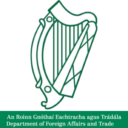Ladies’ Gaelic football is an Irish team sport. It is a form of football derived from traditional Irish ball games.
It is very similar to the men’s version but has a few key differences, mostly related to lifting the ball off the ground and tackling.
It is typically played between two teams of 15 players on a rectangular grass pitch, although here in North America, we play smaller-sized games to suit the smaller sports facilities available.
Positions in Ladies Gaelic football are similar to those in other football codes. They comprise one goalkeeper, six defenders, two midfielders, and six forwards, with a variable number of substitutes. These numbers will change depending on the size of the field available.
Typically, we play with seven players on each side indoors during the winter and nine players on each side outdoors during the summer and autumn months.
How to Play
- Unlike in soccer, where players from each team line up in their own half, Gaelic Football players start a game positioned on either side of the half, and pair themselves with an opposing team’s player. For example, the midfielders from each team will line up together at the centre-line of the field. The forwards will position themselves in front of the opposing team’s goal, and the fullbacks will line up beside the opposing team’s forwards. Defensively speaking, you are now paired with a player from the opposing team, and you will be “covering” that person for the duration of the game
- The game begins with a jump ball between all four midfielders in the centre.
- The ball may be held in the hands, however if the ball is on the ground, the player may pick the ball up with their hands
- Players are given only four seconds or four steps to advance the ball.
- Players can pass the ball by kicking it, or by striking it with one hand while holding the ball in the other (a hand-pass). The ball may not be thrown.
- After four steps, the player may bounce the ball (this bounce is called a “hop”) and take four more steps, kick-pass the ball or hand-pass the ball.
If the player chooses to take four steps after bouncing, they must kick the ball back to themselves (called a solo) after the 8 steps, creating a sequence of four steps-bounce-four steps-solo-four steps-bounce-four steps-solo. etc.
Tackling
- A player holding the ball into their body cannot be legally dispossessed.
- When making a tackle to dispossess a player of the ball, it must be timed when the player in possession is soloing, bouncing, kicking or passing the ball. The ball must be knocked from the opponents hand by flicking it with the open hand or hands.
- There shall be no deliberate bodily contact, shouldering is not allowed.
How to score
In the game, two types of scores are possible: points and goals.
- A point is awarded for kicking or hand-passing the ball over the crossbar, signalled by the umpire raising a white flag.
- A goal is awarded for kicking the ball under the crossbar into the net, signalled by the umpire raising a green flag.
Ladies’ Gaelic football is the most popular ladies’ sport in Ireland and one of the most popular in the world in terms of attendance. The 2019 All-Ireland Senior Championship Final was held at Croke Park, Dublin, drawing an attendance of 56,114 people, putting it second just behind the 2019 FIFA Women’s World Cup Final with 57,900. This also makes the LGFA All-Ireland Senior Championship Final the record holder for the largest-ever attendance at a women’s amateur sporting event in Europe.
Here in Montreal, ladies’ Gaelic games are quite popular. The city plays host to a yearly tournament each May, with teams from all over Eastern Canada and parts of the United States travelling to compete. Ottawa, Quebec, and Toronto will all host tournaments through the summer months, and there is an Eastern Canadian Championship, run by the Eastern Canadian GAA board, which changes location every year.







